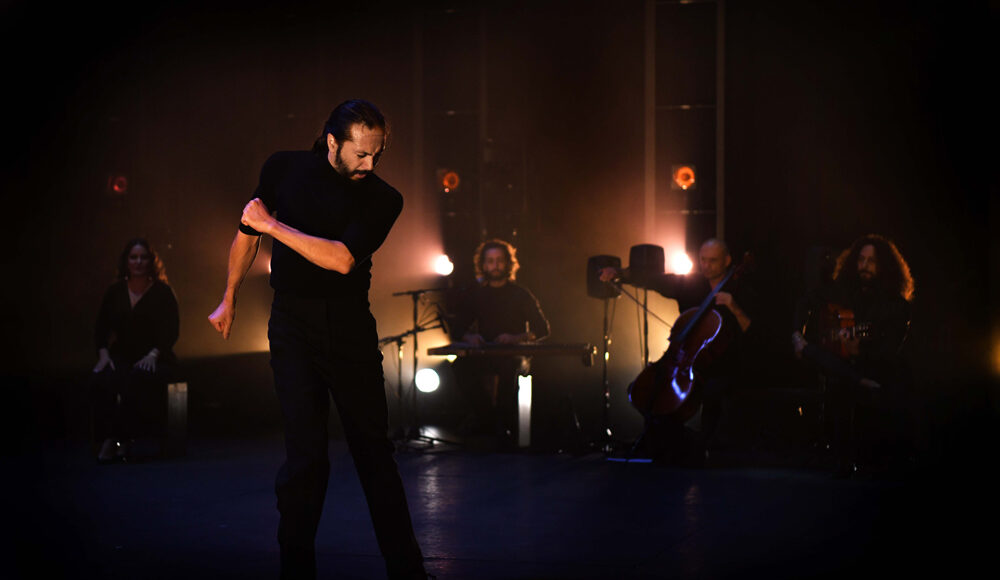By Ernest Kearney — Oxymorons. Defined by assorted dictionaries as, “A combination of contradictory or incongruous words.”
They pour forth from Shakespeare’s plays: “Sweet sorrow,” “feather of lead,” “wolvish-ravening lamb.”
Simon and Garfunkel sang one for us: “The sounds of silence.”
And there’s the classic, “Military intelligence.”
As part of the 2024 Los Angeles International Flamenco Festival, the Ebell Theatre on Wilshire Boulevard presented an evening of “Flamenco avant-garde.”
The incongruity of that term won’t be evident to most, but for an old-school aficionado of the great Spanish art form, “Flamenco avant-garde” is an oxymoron on steroids.
I admit, I have not been exposed to Nuevo Flamenco before, and the first shock awaiting me at the Ebell was a piano. Never before have I seen a piano occupying a stage where guitar, castañuelas and percussion instruments hold dominance.
Nuevo Flamenco initially emerged in 1975 shortly after the long overdue and greatly appreciated death of Francisco Franco. After four decades of fascist dictatorship, suddenly it was allowable for the Spaniards to discuss “change” without needing to worry about arrest by the police of the Brigada Político-Social. At the same time, parts of Spanish society were gripped by “change-madness,” the threats to classical Flamenco from modern variants such as Rock & Roll and K-rap fueled the rise of Nuevo Flamenco.
The Ebell show was meant to highlight those efforts at expanding Flamenco’s appeal to larger demographics and thus opened with pianist Andrés Barrios who wooed and wowed the audience with the graceful vigor of his playing.
Barrios was joined on stage by an artist who epitomizes Flamenco’s global popularity, Japanese-born Mizuho Sato. Well-known to me as a talented and immensely skilled bailaora (dancer,) Sato performed a beloved standard of Flamenco, the baile de mantón. This classical style involves incorporating the flow of a lengthy shawl to accentuate or counterpoint the dancer’s movement.
From the opening moment, the sway of Nuevo Flamenco was immediately present.
Traditionally, at the top of these dances, the bailaora can use the shawl aggressively as a “ganchos” a method for her to ”hook” her audiences straightaway. In past performances, I’ve seen Sato with a snap of her shawl ensnare audiences like flies on a spider’s webbing.
At the Ebell, Sato spun no web. Instead, her shawl was shaped as a chrysalis from which Sato emerged with the elation of a butterfly’s first embracing flight. Sato’s performance, with layered elements of ballet and robo-popping proved completely captivating.
Taking to the stage next, featured bailaor/cantaor José Maya departed further from classical forms. Maya imbues his songs with the raw vitality essential to Flamenco, a quality labeled in the jargon of dance as “garra,” literally “claws.” These moments, however, are wedged between prolonged placid stanzas, defusing their impact to an extent.
Throughout both Maya’s performance and the evening, projections of superbly crafted computer animation set the backstage wall ablaze: scenes of a stark, surreal landscape, lightning bolts erupting from a storm darken, flocks soaring blue skies.
The works are beautifully executed. One might even be tempted to describe them as “bonito,” but in the parlance of Flamenco “pretty” is not given as a compliment.
While uncertain what these visual embellishments added, the cost of their incursion was the loss of that austerity and starkness found in the peña clubs and other stages Flamenco commonly appears in. In these venues, it is amazing to witness how the emptiness is filled to breaking by the artists themselves.
The Ebell’s stage was not lacking in talent, quite the opposite. To those already cited add cantaor and cantaora, Ismael de la Rosa and Delia Membrive whose remarkable voices trembled the walls of the theatre like the awakening of a long dormant sub-terraranan volcano beneath Wilshire Boulevard.
Guitarist Rycardo Moreno, a major figure in avant-garde Flamenco, displayed a mastery of his instrument that was spellbinding. Until you’ve experienced a guitar in the hands of a Flamenco tocaor you have never seen one played.
One needs to understand that flamenco is not simply steeped in traditions, it is entrenched in them.
Flamenco is a clashing of cultural undercurrents that became the folkloric art of an ancient and tragic people. Given many names – Dom, Kalderash, Gypsies, Tinkers, Travellers, Romani – these ostracized, despised “outsiders” wandered the width of Europe, enduring the fires of the Inquisition’s and the gas of Nazi’s “Death Camp.
Defenseless before their persecutors they danced in defiance of defeat, sang joyous in denial of death. They weaponized their passion in order to make survival their victory.
Coming to the Iberian peninsula, these “outsiders” applied their artistry and drew on the influences of countless cultures to create the purest expression of the human soul.
The Moorish masters who then ruled the lands reviled them as “fugitive -peasants.” In the Arabic tongue, “Felag – mengun.”
Time’s passing would render down their ancient affront to flamenco.
Everyone should see Flamenco. For some it is a life-altering experience. Traditional or Avant-garde it doesn’t matter. My lovely wife Marlene loved every moment of our evening at the Ebell.
Flamenco traditionally has found definition in a certain minimalism and brevity of form, and these are the very qualities being challenged from the Ebell stage.
My feelings toward any evolution of this sublime and wonderous folk art that I love are conflicted to say the least. It is my nature to lean toward the spartan and traditional.
However, whenever there’s doubt in the artistic realm one cannot hesitate in choosing change.
The creative must always step bravely forward into the mystery of newness that the future holds, they cannot recede back into the familiar with its stale, stagnant shadow of safety.

Art suffocates in safety.
As those on the Ebell stage know.
Interest in learning more about Flamenco?
Visit Flamencolive.com
• “An extract of poison and fire, this is flamenco,” Antonio Gades.





